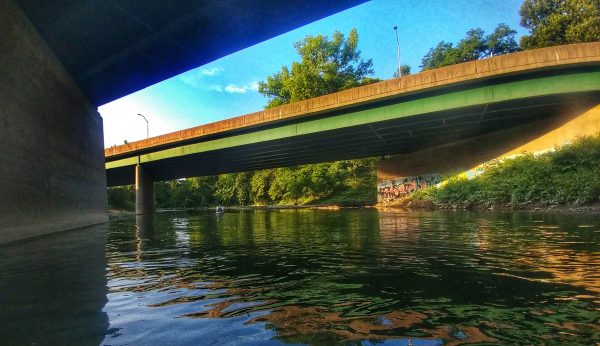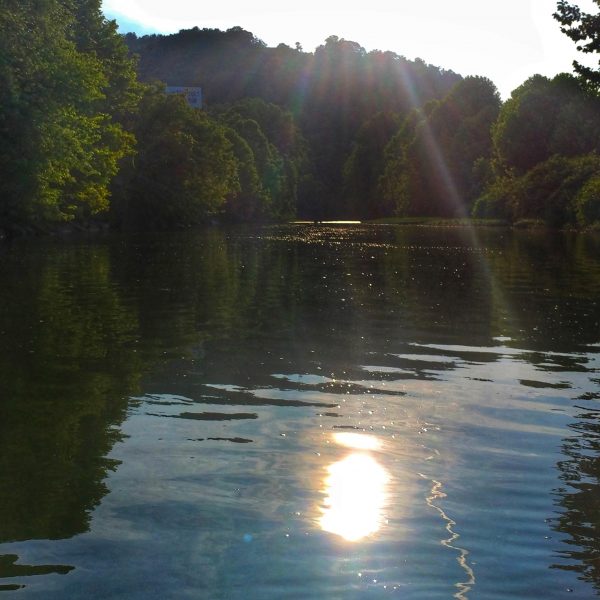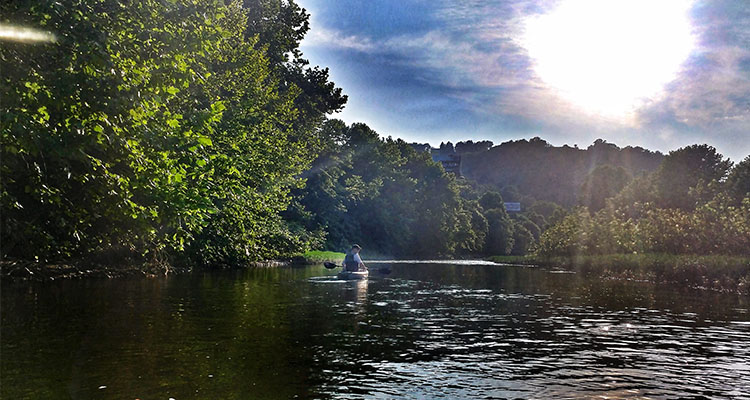I recently paddled Wheeling Creek for the first time. I’ve paddled other rivers like the Youghiogheny, the South Branch and the Cheat. I’ve meant to do Wheeling Creek — it was just a matter of logistics. All our kayaks were stored at Piedmont Lake, and I didn’t know how to get them back to Wheeling. Finally, I bought a kayak rack.
Paddling Lower Wheeling Creek
My husband and I parked a car at the take-out at Kroger and drove our kayaks to the put-in beside the Italian-American Club in Elm Grove, behind Patterson Ballfield. There’s a gravel lot and easy river access there, and you can walk your boats down to the beach, though you’ll find it rather mucky (wear water shoes and prepare for odorous mud). In addition to a PFD (personal floatation device), drinking water and sunscreen, consider what you’ll need when you arrive at the take-out, like car keys and maybe a lock for your kayak if you’ll be leaving it there during shuttling. A waterproof case for your phone is helpful for photos and calling for assistance if necessary. Fortunately, the creek follows roads and neighborhoods for the entirety of the trip, so help is never far away.
Water levels were low: it had been over a week without rain. The desirable level is generally two to four feet — you can check Wheeling Creek Hydrograph for a status report at any time. But, for the sake of my writing deadline, we donned river shoes and went into the trip knowing we’d have to drag the boats in a few places. (The hard, plastic boats you buy at Walmart and Cabela’s are built to handle this type of abuse; whitewater kayaks are not.) Low water often arrives with the summer heat, and if you’re itching to paddle, just accept that you’ll have a few bumps and maybe a wet walk or two. We had to walk our boats just once, behind Elm Grove Dairy Queen, for about 50 feet.
If you’re looking for rapids, Wheeling Creek in the summer isn’t the place to find them. It’s a great place to fish, float along lazily or paddle hard for an upper body workout. We spent the four miles paddling steadily, and it took us about two hours. Obviously, times vary with water levels, and on the day after a rain, you may zip along in an hour.
Safety
Safety on the river is of the utmost importance. Keep in mind that you need to be responsible for yourself, for your kids, and consider the rescue personnel who’ll be called out into a dangerous situation if necessary. By making sound decisions, you keep a lot of people out of harm’s way. The most basic safety precautions include telling family or friends where you’ll be and when you expect to return, bringing a life jacket, using alcohol responsibly and understanding the dangers of a river. A sudden storm can produce high water; it’s best to get off the creek if this happens. Also, be aware of objects in the water like piles of rubbish and downed trees. Kayakers call these “strainers” because the water passes through them but pins your boat and body. Strainers can be deadly. If you see an obstacle in front of you, pull off and inspect the obstacle on foot. Portage around if necessary.
A serious note: Paddle sports deaths are at an unprecedented level, largely due to a phenomenon called the “Kmart Kayaker.” In the past, kayaks weren’t so readily available. Now, you can buy them at Walmart or Dick’s or Kmart.
According to Jim Emmons of the Water Sports Foundation, “You can go into Costco, get groceries, and walk out with a 12-pack and a kayak. But nobody is telling you about how you need a lifejacket, or that the water temperature might be 50 degrees.” (source: Adventure Sports Network) If you’re brand new to the sport, recognize that fact. Never eschew a life jacket. Consider paddling conditions (weather and water). And check out this video on what to do if you flip your boat.

Planning
When it comes to planning your paddle, the City of Wheeling’s Interactive Water Trail Map offers helpful information on launch sites, fishing holes, landmarks, and eateries. Jesse Mestrovic, director of parks and strategic planning for the City of Wheeling, is an avid outdoorsman and the man responsible for providing such recreational information. He’s worked at West Virginia state parks, Seneca Lake and for the city of Moundsville. Not only is he a regular creek paddler, but he’s also working to improve the experience for everyone through his position with the city by offering information on things like access points, water quality and wildlife. His goals are the care of our waterways and helping people enjoy them.
“I want to creak a kiosk for Wheeling Creek,” Mestrovic said. “Especially out at Patterson [ballfield]. It would be a map of the creek with some nature interpretation. We’re just trying to educate people, to get some stewardship elements out there. We have identified species that we thought would be attractive like the hellbender, and then having a picture of the hellbender. That animal’s cool. Obviously, we’d have the great blue heron, and birds you can identify and see and maybe even have some indicator species, like the hellbender, where water quality issues are important.”
While Wheeling Creek’s “water trail” status has made it popular both upstream and down from the Patterson ballfield access point, Mestrovic wants people to know that the paddling opportunities in the Ohio Valley are myriad.
“To me, it’s about identifying waterways in the region,” he said. “You know, what can you paddle? Buffalo Creek, to me, is the best. Also, when the water is too low, where can you go? You can go to Fish Creek, Captina Creek, to our lakes and reservoirs.”

Going With the Flow
After a two-hour trip, Shawn and I pulled our kayaks out on the bank at Kroger. That was when I realized I didn’t have my car keys. Thankfully, we live in Wheeling, where everything and everyone is usually only a few minutes away. Fellow Weelunk writer Christina Fisanick came to the rescue and found us sitting pitifully in the dirt beside the parking lot.
The key to a successful day of paddling is adaptability. And while my lost keys proved to be an inconvenience (I found them on top of the car we’d left in Elm Grove), the real tests may come when paddlers aren’t expecting them.
Mestrovic told me about a paddle he took on Buffalo Creek with some folks who were new to the sport. An evening thunderstorm hit, and the creek rose rapidly. What began as a relaxing paddle turned dangerous. Smaller creeks filled their banks and rushed into the larger stream. Limbs and logs floated by on chocolatey water. It was scary, Mestrovic said, but he had the river experience to get the group off the water as soon as possible. That’s where common sense and safety come into play and why it’s so important to paddle a new creek with kayakers who know the water.
Find a Buddy
The Creek Yakkers Facebook group is a great place to find such people. Here you’ll find an online community of kayak-loving folk who are more than happy to dispense advice and offer suggestions. If you’re looking for someone to paddle with, they’re always up for a trip. It’s a great way to meet new people and learn the local rivers, not to mention share shuttle duties and tips on creekside eateries. Hop online, introduce yourself, ask questions and join the community. You’ll be welcomed.
Ecology and Wildlife
Kayaking is a great way to enjoy nature, but make no mistake: the paddle to Kroger is a noisy one. The interstate roars above and beside you most of the trip. I most enjoyed the bend around Wheeling Jesuit because the sound of traffic was replaced by the sounds of chattering kingfishers. We saw baby ducks, numerous herons and kingfishers, deer, bass and carp. A grinning fisherman told us he’d just landed an 18-inch walleye, and a friend recently encountered a mink upstream in Marshall County.
The presence of life is a direct indicator of the health of a stream. Wheeling Creek faces some ecological challenges, the most noticeable being sewage. Indeed, at certain points along the creek, the smell is strong. It gave me pause.
Buffalo Creek, near Bethany, on the other hand, is doing fairly well, for now, but Mestrovic is concerned.
“The cleanest stream in the northern panhandle is Buffalo Creek, but it’s diminishing every day,” he said.
To learn exactly what that meant and what we can do about the vitality of our water trails, I needed to find an expert.
I found one at West Liberty University.
PART TWO: Below the Surface
(Photos by Laura Jackson Roberts)
• Laura Jackson Roberts is a freelance writer in Wheeling, W.Va. She holds an MFA in Creative Writing from Chatham University and writes about nature and the environment. Her work has recently appeared in Brain, Child Magazine, Vandaleer, Animal, Matador Network, Defenestration, The Higgs Weldon and the Erma Bombeck humor site. Laura is the Northern Panhandle representative for West Virginia Writers, a blog editor for Literary Mama Magazine and a member of Ohio Valley Writers. She recently finished her first book of humor. Laura lives in Wheeling with her husband and their sons. Visit her online at www.laurajacksonroberts.com.


